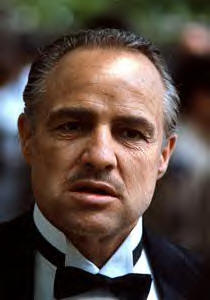In Remembrance: Marlon Brando
 Marlon Brando, the actor who brought the style known as the Method from
Broadway to Hollywood and has been called by many as the greatest actor ever
has passed away in Los Angeles on Thursday July 1, 2004. He was 80.
Marlon Brando, the actor who brought the style known as the Method from
Broadway to Hollywood and has been called by many as the greatest actor ever
has passed away in Los Angeles on Thursday July 1, 2004. He was 80.
Born April 3, 1924 in Omaha, Nebraska to alcoholic parents, Brando had a troubled childhood, getting expelled from many schools (one time for riding a motorcycle through its halls) including a military academy. Following the prompting of his father to find some direction in life, he moved to New York City where he studied acting and the Method style at the New School with Stanislavsky before going to the Actor’s Studio for further training with Lee Strasberg and Stella Adler. A series of rave reviews for his summer stock work lead to his first Broadway role in the 1944 production of I Remember Momma. Several other roles followed, culminating in his essaying of the brutish Stanley Kowalski in 1947 A Streetcar Named Desire.
“Kowalski was always right and never afraid,” Brando once said. “He never wondered, he never doubted. His ego was very secure. And he has the kind of brutal aggressiveness that I hate. I’m afraid of it. I detest the character.”
Heading to Hollywood in 1950, his first screen role was in The Men, where he prepared for the part of a resentful paraplegic by lying in a bed for a month in a veteran’s hospital. Brando next recreated his stage characterization of Kowalski for the film adaptation of Streetcar in 1951 for director Elia Kazan. The film was a hit and earned Brando the first of for consecutive Academy Award nominations for Best Actor. He was also nominated for the films Viva Zapata! (1952) On The Waterfront (1954), both with director Kazan, and Julius Caesar (1953). He would have his first win for his layered performance as a washed up boxer in Waterfront.
The rest of the 1950s found Brando taking a variety of roles. He portrayed Napoleon in 1954’s Desiree and tried his hand at musicals in 1955’s Guys and Dolls in the role of Sky Masterson. The Teahouse Of The August Moon (1956) found him playing an effeminate Japanese interpreter and a year later he portrayed an American serviceman stationed in Japan in Sayonara, for which he received another Academy Award nomination. He played a Nazi officer in the drama The Young Lions in 1958 and a vagrant in 1959’s The Fugitive Kind.
Brando took his one attempt at directing with the 1961 western One-Eyed
Jacks. The film was not well received and marked the beginning of a
decade of decline for Brando. The 1962 remake of Mutiny On The Bounty,
with Brando’s Captain Bligh played against Clark Gable’s Fletcher Christian,
suffered cost overruns and fell behind schedule due to his desire to
improvise. Attempts at comedy, including A Countess From Hong Kong
(1967) directed by Charlie Chaplin, fell flat.
Brando’s career had bottomed out to the point where he actually had to audition for the role of Mafioso boss Vito Corleone for Francis Ford Coppola’s epic gangster film The Godfather (1972). The performance not only restored his reputation as an actor but also earned him a second Academy Award for Best Actor. He followed this up with yet another Oscar-nominated performance in the steamy Last Tango In Paris (1973). He received the sum of $4 million for his relatively short screen time portraying the father of Superman in the 1977 comic adaptation, where he reportedly couldn’t be bothered to memorize his lines and had them scattered about the set on cue cards out of camera range. He reteamed with director Coppola for the 1979 Vietnam War picture Apocalypse Now.
Brando earned his last Academy Award nomination in 1989 for A Dry White Season. He parodied his Vito Corleone character in the 1990 comedy The Freshman. He appeared in a handful more films including Don Juan DeMarco (1995) and The Island Of Dr. Moreau (1996). His final film was the 2001 heist film The Score.